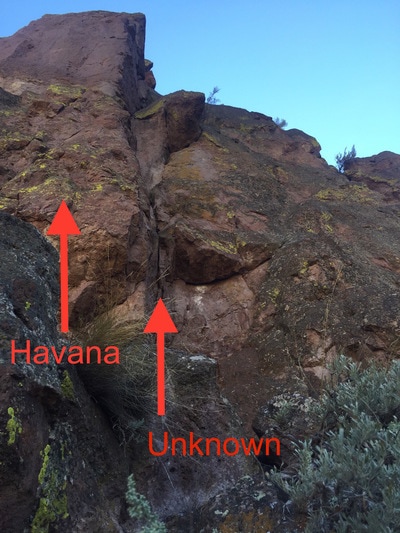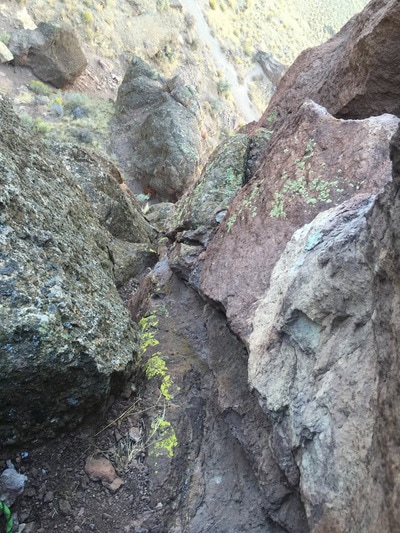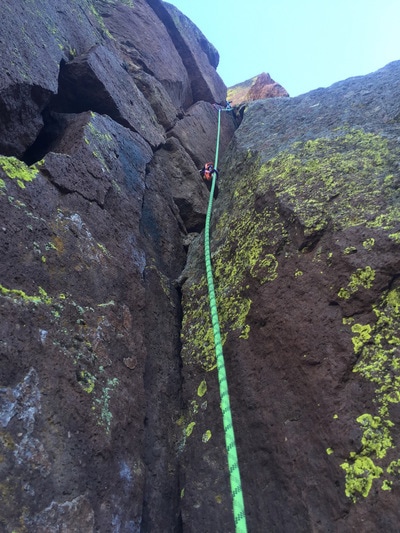I had a plan - easy trad multi-pitch. In fact, when left to my own devices, that’s often my plan. Easy, trad, multi-pitch.
There is another attribute I have that often influences my plans –curiosity, boredom, the desire for “next,” whatever the label, those words translate to “I rarely climb the same route twice.” (Which is probably one reason why I don’t climb “harder” than I do…).
I was hanging out at the Smith Rock “bivy” campground eating breakfast and thumbing through the guidebook to find a long, easy trad route I had not yet climbed. I was hoping I could talk my husband into going on this climb with me, but he was non-committal and stirring up different plans.
I struck up a conversation with another woman at an adjacent table. We chatted about our recent climbs at Smith, she described how she and a friend were on a two-week road trip from California, then she lamented that her friend injured himself the day before. Since my hubby was off in “I-don’t-know-land,” I offered to climb with her.
She piped up with excitement and we discussed the type of climbing we liked and desired to do. "Easy trad multipitch," she said. Yes! I love this woman!
Since she was new to Smith, she was game for “whatever.” I proposed Havana, a 3-pitch 5.7. The guidebook description was “A completely ignored route wanders up an obscure crack system on the north face of Red Wall.” Perfect.
I was reasonably familiar with the Red Wall, having done numerous climbs there, so I was not too concerned about the lack of a photo of the route. I surmised that I could deduce the location of the climb from it’s scrunched up location in the drawing and the verbal descriptions in the guidebook - “Start uphill right of Breakdown in Paradise below an ugly trough.” Perfect.
I assembled my trad rack – it says gear to 4-inches, so I grabbed the #5 as well. I have a habit of always taking one piece of pro larger than the largest size listed for the climb, which has saved my ass numerous times.
There is another attribute I have that often influences my plans –curiosity, boredom, the desire for “next,” whatever the label, those words translate to “I rarely climb the same route twice.” (Which is probably one reason why I don’t climb “harder” than I do…).
I was hanging out at the Smith Rock “bivy” campground eating breakfast and thumbing through the guidebook to find a long, easy trad route I had not yet climbed. I was hoping I could talk my husband into going on this climb with me, but he was non-committal and stirring up different plans.
I struck up a conversation with another woman at an adjacent table. We chatted about our recent climbs at Smith, she described how she and a friend were on a two-week road trip from California, then she lamented that her friend injured himself the day before. Since my hubby was off in “I-don’t-know-land,” I offered to climb with her.
She piped up with excitement and we discussed the type of climbing we liked and desired to do. "Easy trad multipitch," she said. Yes! I love this woman!
Since she was new to Smith, she was game for “whatever.” I proposed Havana, a 3-pitch 5.7. The guidebook description was “A completely ignored route wanders up an obscure crack system on the north face of Red Wall.” Perfect.
I was reasonably familiar with the Red Wall, having done numerous climbs there, so I was not too concerned about the lack of a photo of the route. I surmised that I could deduce the location of the climb from it’s scrunched up location in the drawing and the verbal descriptions in the guidebook - “Start uphill right of Breakdown in Paradise below an ugly trough.” Perfect.
I assembled my trad rack – it says gear to 4-inches, so I grabbed the #5 as well. I have a habit of always taking one piece of pro larger than the largest size listed for the climb, which has saved my ass numerous times.
Annette (whom, for entertainment value, I will refer to as Dorothy) and I walked to the base of the wall, scrambled up steep, loose, scree, found an ugly trough of some sort, studied the cracks in the wall and geared up. I read the guidebook description - Pitch 1, “follow a flaring crack to a ledge.” Flaring crack…let’s see…there is a tiny crack that goes up a face and I can’t really see what it does, or there is a decent sized crack that goes on-and-on up a corner.
I pondered the use of “flaring” in the description. Flaring usually refers to inner features of a crack that you often can’t see. It is often a message that your protection may not stay in place very well. Sometimes, however, it can describe a visibly widening crack. But, since I could not see any obvious "flaring" I decided I could not really use that bit of information to help identify the climb. It did prompt me to grab an extra set of nuts, since some types of flaring cracks do better with nuts than cams.
I continued to study the wall and features, going back and forth between the drawing, the wall, the drawing, the wall. Really, I can’t tell shit. But that long continuous crack mesmerized me, lulled me in. That had to be the climb.
Upon later reflection, I realized I ignored two key words in the initial route description - “obscure crack.” Instead, I chose the other o-word – “obvious” – by deciding to climb the nice long obvious crack. I should have known the guidebook would have said “obvious” if it had the opportunity to do so.
I started up the first pitch and grumbled about how shitty the rock was. Why didn’t the book mention that the first 20-30 feet was a crumble-fest? Then, just as the rock quality improved, I hit a really awkward bulge with terrible feet and two options for pro – bad and worse. Fuck me.
At that moment no move was clear. My leg started to Elvis and my arms were getting pumped from a marathon session of looking. I did not want to fall on gear placed in crumble, so I down-climbed, tugged on my last piece to make sure it was solid, and asked Dorothy to take. As I sat and rested in relief, here was my internal conversation:
- Wow, this ain’t no 5.7.
- Well, Stef, it rarely is. That is why you wrote an article WTF 5.7?
- True, there is usually at least one WTF move on trad 5.7s. Maybe this bulge is it. But why didn’t the guidebook mention the crappy rock? Didn’t this climb receive 2-stars? This is not 2-stars.
- Who knows how those star ratings are made. You can’t expect every guidebook author to have climbed a climb and confirmed the description. He did say it was rarely climbed, and that usually means loose rock.
- I’m considering bailing.
- Really? Come on, you can do this. It’s a 5.7 for crying out loud! Plus, I don’t see any natural features you can use to lower. You will lose gear.
- Damn.
I studied the area above closely and prepared a small cam and several nut options for the tiny crack to the right of the bulge. “Climbing” – I called down. Slack entered the rope.
At the bulge I fumbled with gear, Hail Mary-ied, and hulked my way past with grunts that echoed across the surrounding walls. “Jesus!” I yelled and finally slammed a piece in the crack above me. “That was it, the crux move” I thought to myself, allowing some relief to flood my body. But the bulges and tricky moves kept coming. WTF was the theme thus far.
I finally reached a spot that I wouldn’t call a ledge (the guidebook said there was a ledge...), but, rather, “ledge-ish.” So I built an anchor and brought up Dorothy. She arrived with a look of half-pride and half-dismay, “Nice work,” she offered, “I’m glad I didn’t lead that.” I appreciated the confirmation that the pitch was definitely a damn-hard 5.7.
I asked her if she wanted to lead the next pitch. “Sure!” she piped up. Thinking we might still be on Havana, I read her the Pitch 2 description. “Jam and lieback to an unexposed shelf.”
“That sounds good,” she replied
Dorothy then graced her way up the corner and followed the crack onto a slabby face.
“This rock is really slick!” she yelled down. “There is a ton of lichen.” She gingerly placed the balls of her feet on the rock to maximize friction. Bits and pieces of debris rained down. She made her way past the slab, back into a corner system and then stopped.
“I am going to stop here. There is a good sized roof.”
What? Did she say roof?
She built an anchor and brought me up into this cramped spot where our bodies collided and fought the odd angle. The roof above prevented any upright body position.
“Thanks for your lead Dorothy, nice work on that slab!”
“Slab – not my favorite. I was counting on layback and jamming!” She was right. That pitch had nothing that sounded like Pitch 2 of Havana.
“Dorothy, I think we are on the wrong climb,” I finally verbalized what had been swimming in my head.
“Oh shit,” she replied. “Should we bail?”
I had been considering that option quite seriously, especially with a roof pressing up against my face. I leaned over to see if the upward slope of the hill would make a rappel possible by bringing the ground closer. No such luck. Even if I left gear, I didn’t think the 70m would get us to the ground. Unless I donated a significant portion of my trad rack to rap down the route, we needed to finish this climb.
I inspected the roof. It was split by a large crack – it would only take a #5 down low (thank God for the #5!) and the crack widened as it moved upward. There were no holds on the face. The only way up was in – a fucking offwidth.
“Sorry, Stef, I don’t want to lead this,” Dorothy admitted. I whimpered. I wished Dorothy could tap her heels three times and make it all better.
Looking for alternatives to the roof, I tried to peer around the right side. I could not see much, just a thin, unprotectable ledge that lead somewhere. I was faced with the choice of going with what I could see – a roof offwidth with what appears eventually lead to a big ledge – or going with the unknown – an unprotectable thin traverse that lead to what - perhaps another unprotectable roof offwidth? The inability to backtrack, the lack of protectably on the traverse, the swing potential of a fall, and the rope drag from going around a corner compelled me to choose what I could see – straight up, into the crack.
I gathered my wits and listened to the laugher of children as they skipped along the main trail below. I was tempted to just yell out “help!”
"Climbing.” I mustered with the enthusiasm of a deflated balloon.
Standing on my tip toes, I worked my arms in and high and prayed my feet wouldn’t slip. I felt around for something, anything, to grab. There was a small lip inside. I grabbed and pulled up with all my might, yelling at the top of my lungs. I wedged in, precariously, then placed the #5 in the huge crack (did I say thank God for the #5?!).
I inched upwards and desperately pulled a foot up into the crack, almost knocking the cam. I wished I could stand on it, but, as it was, it floated there on very little, threatening to walk back into the crack that opened wide above and behind it.
I fought further into and up the now-unprotectable crack, struggling for every upward movement. My whole body shook from adrenaline, fear, and frustration. “Fuuucccckkkk! Fuuccckkk this!! Mother fuuucker!!!” I screamed without a second thought of the parents who might have to explain to their kids what is happening way up high on the rocks.
I was as committed as committed could be – half a body in a crack, one piece of sketchy pro now far beneath me, and a ledge in sight above. There was no choice but to finish.
Now, some people like this kind of rock climbing – where commitment and fear force you to excel and push boundaries. People speculate, how would you know your limits if you never pushed them? Wise claims are made like “getting sandbagged makes you a better climber.” True for some, but I will take my soft, warm, comfy zone of easy trad multipitch, thank you very much. Why? Because it’s easy, fun, and sprinkled with a manageable amount of spice. But, at that moment wedged high above my pro, I was not getting a little douse of Tobassco. I was getting a whole damn bottle ghost pepper hot sauce.
Yes, I made it – out of pure, utter desperation. If you can imagine the most ungraceful, panicked, clawing, beached-whale exit you have ever seen, that was me. And once on tierra firma, I cried in relief.
After my teary release while splayed flat on the ledge, I added more pro and built the anchor. Once on belay, Dorothy wedged her way partially up the roof, grabbed the #5, then bailed, opting to give the ledge traverse a go. Turns out there is a la-de-da 5.easy path to the top around the corner. Fuck me.
*** Post assessment – I tried to determine if this climb has been named or graded. I know we are not a first ascent (Smith has been climbed so much it’s almost impossible to have a trad first ascent). I contacted local guides, looked on Mountain Project, and posted to a Portland rock climbing Facebook group, to no avail. So Annette (aka Dorothy) and I conversed and decided to grade the pitches as follows: P1 – 5.10a; P2 – 5.9; P3 – 5.11a. Someday I will find out what others rate the climb. It will probably be a 5.7. ****



